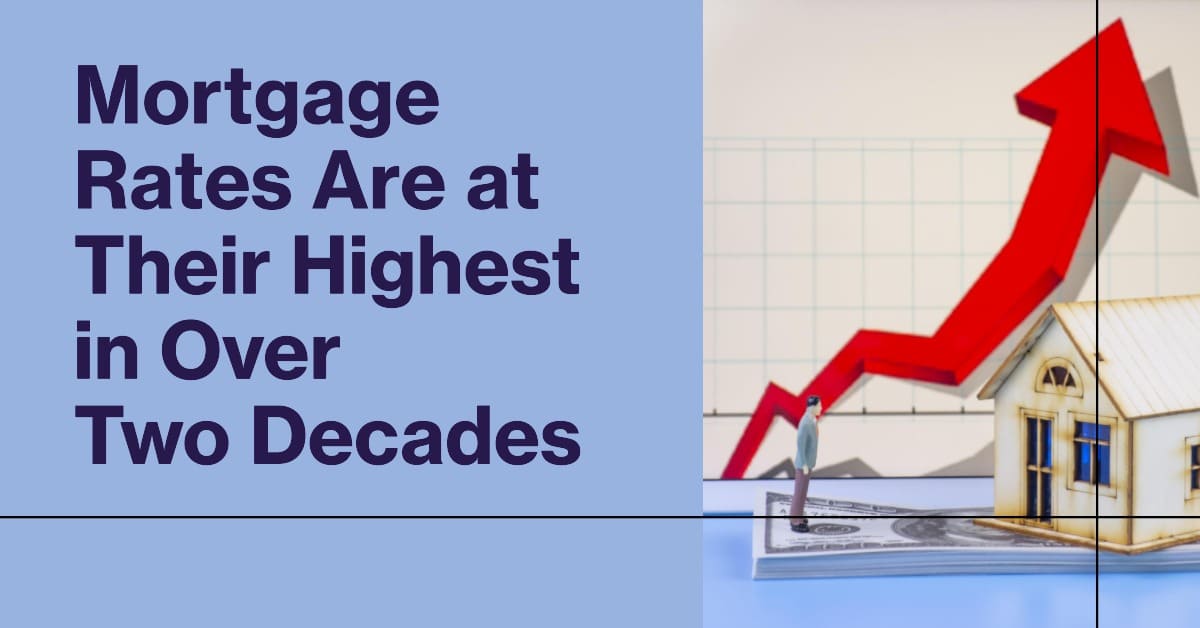
Americans seeking to secure mortgages for their homes are now grappling with the highest mortgage rates in over two decades. The average interest rate for a standard 30-year fixed-rate home loan has surged to 8% for the first time since 2000. This data comes from Mortgage News Daily, a trusted source for tracking mortgage rates.
The Mortgage News Daily Rate Index has officially hit 8.0%, marking the highest mortgage rates in 23 years. This milestone comes as no surprise, given the prevailing upward trend in rates, with minor fluctuations along the way.
Mortgage Rates Are at Their Highest in Over 2 Decades
While this headline-worthy figure may grab your attention, it's essential to understand the context. The mortgage rates on Oct 18, at 8%, are only a slight increase from Oct 17's 7.92%, which was itself the highest rate in 23 years. The breach of this 23-year ceiling initially occurred in late 2022, with a subsequent challenge in August of 2023.
Since then, we've experienced a series of new long-term highs, with seven such instances in less than a month, notably following the Fed's September 20th announcement. These frequent rate highs might seem disconcerting, but they are indicative of a market adapting to a “higher for longer” interest rate environment.
In such scenarios, market patterns exhibit smaller but more frequent fluctuations between rate highs and lows. So, today's record-high is just another step on the same path.
But what's next? Are we on a trajectory towards 10% mortgage rates? It's too early to predict. While it's unwise to rule out the possibility of rates climbing further, there are several factors at play. If the economy softens as the Fed anticipates and inflation remains stable, the upward rate momentum should gradually subside.
However, one significant variable is fiscal policy and government spending, which has recently raised concerns in the financial markets due to its potential impact on Treasury issuance.
Treasury issuance is crucial, as it sets the tone for most other interest rates in the United States. Higher-than-expected issuance can drive up government costs to attract sufficient demand. This trend typically ripples through to mortgage rates, as mortgage-backed securities tend to move in tandem with Treasuries. Whenever the government announces significant spending initiatives or legislation with implications for lower revenues, the bond market risks breaking another rate ceiling.
The upswing in mortgage rates is a consequence of the Federal Reserve's efforts to combat inflation by raising interest rates. Over the last two weeks, rates have escalated by almost half a percentage point, signifying a swift and significant change.
These rate hikes are part of the standard strategy employed by central banks worldwide to control rising prices. In the United States, higher fuel costs have been a key driver of inflation. The central bank's interest rate increases have been further propelled by strong job growth and increasing expectations for rate hikes.
However, recent market volatility in mortgage rates has been influenced by significant shifts in demand for US government debt, sold in the form of US Treasuries. Political turmoil in Washington, coupled with mounting US debt levels, has raised questions about investor appetite for US debt. As a result, prices of Treasuries have fallen, causing yields to rise. This, in turn, has affected mortgage rates, making them more expensive for borrowers.
Matthew Graham from Mortgage News Daily notes that markets have become increasingly sensitive to events that may impact government borrowing. He suggests that the recent spike in mortgage rates may be linked to expectations of substantial overseas military spending proposed by President Joe Biden.
The impact of these rising mortgage rates is already visible in the US housing market. Just two years ago, mortgage rates were around 3%. Now, sales of existing homes have declined by 15% compared to the previous year.
Prospective buyers are withdrawing from the market, while current homeowners with lower mortgage rates are choosing to stay put, causing a decline in sales according to the National Association of Realtors.
Despite the decline in sales, house prices have not yet fallen. In fact, they were up by nearly 4% in the same month, as the demand still surpasses the supply.
Many analysts believe that the Federal Reserve will not significantly increase interest rates further, citing the substantial slowdown in price increases since last year. The inflation rate, a key metric for measuring the pace of price increases, dropped to 3.7% in September.
However, the financial markets have been rattled by unexpectedly robust economic data in recent days. This has raised concerns that the Federal Reserve might need to take further action to bring inflation back to its 2% target. Consequently, interest rates could remain higher for a more extended period in the coming year.
The Federal Reserve's key rate currently ranges between 5.25% and 5.5%, a substantial increase from the near-zero levels in March 2022. These rates have a direct impact on borrowing costs for mortgages, credit card debt, and other loans.



